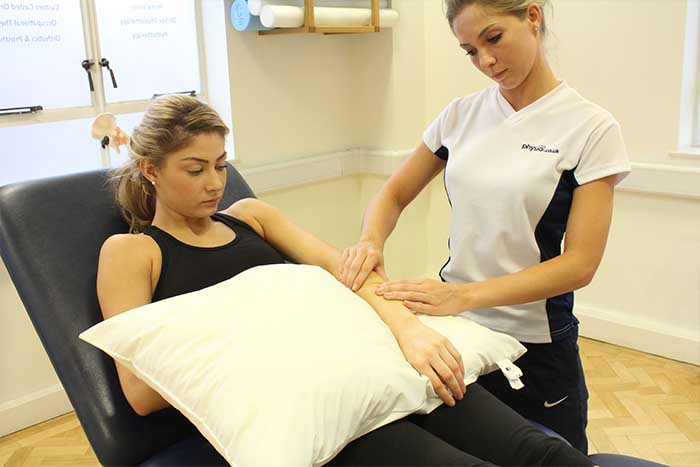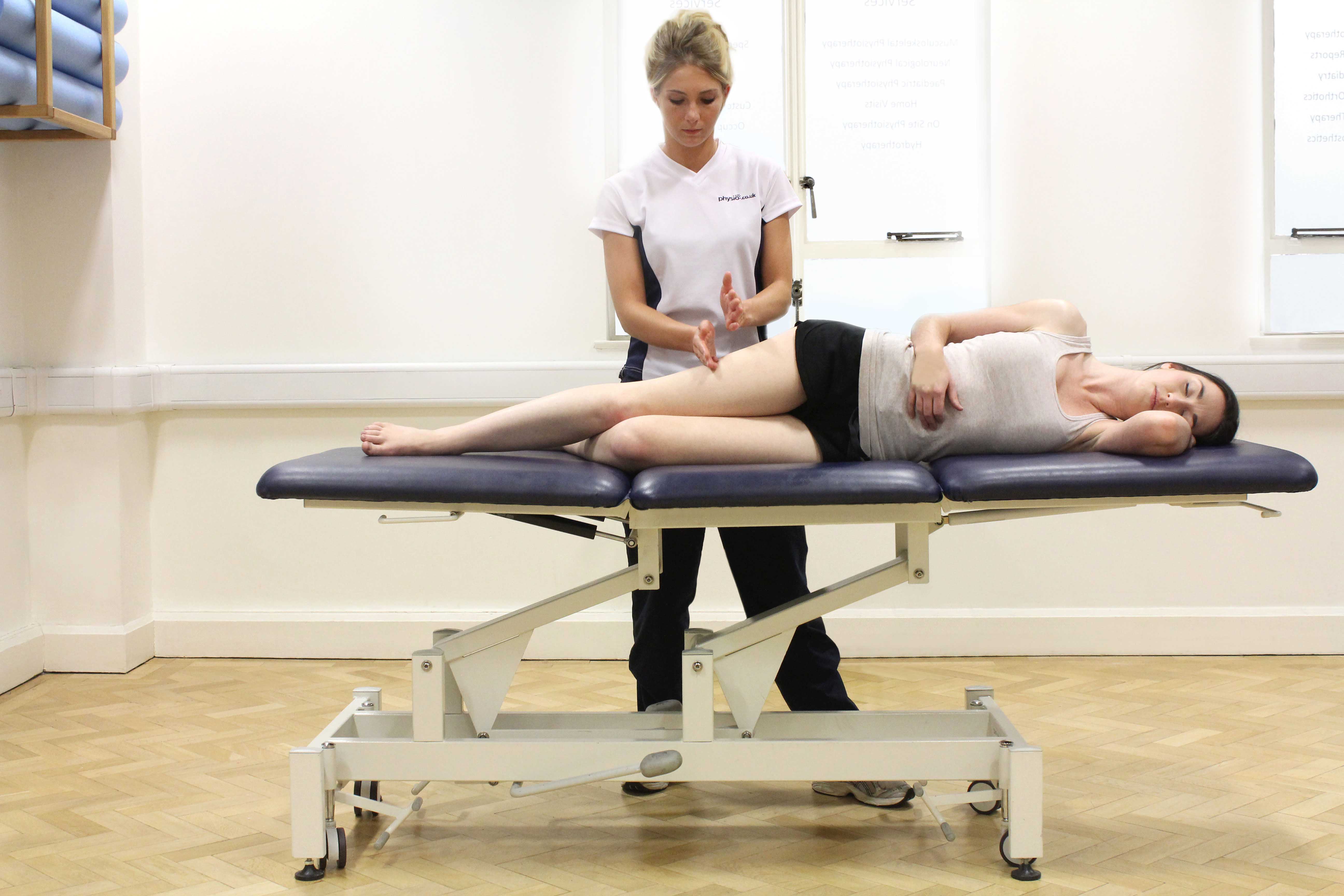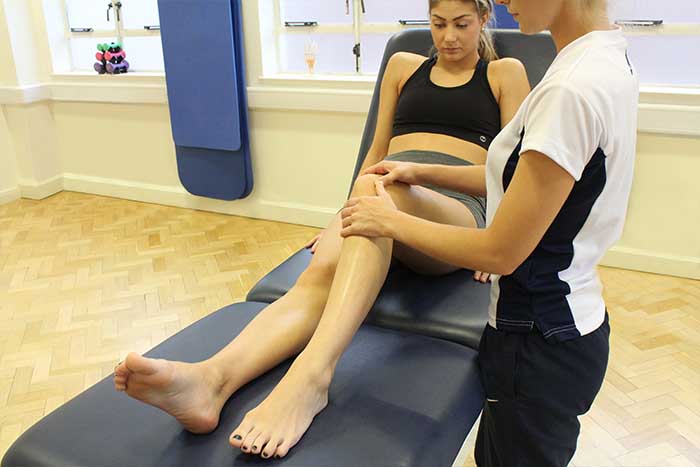People with chronic pain use massage therapy as a treatment modality due to its ability to increase quality of life. Individuals suffering from chronic pain experience both physical and psychological limitations. Physical limitations such as pain, limited range of motion, stiffness and reduced performance. Psychological limitations such as depression, mood swings and feelings of helplessness. The therapists at Physio.co.uk can use a variety of massage techniques to target both physical and psychological limitations associated with chronic pain.
What is massage for chronic pain?
Chronic pain can be defined as mild or excruciating pain lasting longer than 6 months. Chronic pain can take both a physical and emotional toll upon an individual and can leave the individual feeling helpless if left untreated. Chronic pain can stem from many sources, such as a trauma, injury or infection. However in some cases, chronic pain may have an insidious onset.

When can massage help chronic pain?
Massage treatment can be extremely beneficial when applied during a range of circumstances such as;
 Above: Hacking percussion massage of the vastus lateralis muscle by a specilaist massage therapist
Above: Hacking percussion massage of the vastus lateralis muscle by a specilaist massage therapistMassage treatment can benefit an individual when applied post injury. If an injury has failed to complete the healing process successfully the individual can be left with chronic pain. Following injury the surrounding muscles can become tense, causing other muscles in surrounding areas to compensate which can lead to muscular fatigue and further injury. Massage can increase tissue temperature and elasticity through increasing blood circulation. Increasing blood circulation can also assist the body's natural repair process by bringing machrophages, mast cells and fibroblasts to contact damaged or dead tissues.
Massage can also be beneficial when applied to tight muscles. Tight muscles are common during the presence of chronic pain due to the possibility of muscular guarding. Muscular guarding is when muscles become tense and tight to protect an injury site. If left untreated tight muscles can result in pain, stress, and an increased chance of injury. The application of massage can decrease muscular tightness by increasing the temperature and elasticity of tissues and realigning collagen fibres. The application of massage to tight muscles can increase range of movement, tissue flexibility and performance.
Massage can be beneficial when applied in the presence of scarring. Scar tissue is comprised of type 3 collagen fibres which have great tensile strength but weak compressive strength. Type 3 collagen fibres are laid down in a hazardous fashion over an injury site as part of the healing process. The hazardous formation of type 3 collagen fibres makes the tissue non-functional as the fibres have low elasticity and flexibility which can limit range of movement and performance. Massage can break-up the presence of scar tissue using compressive forces and align the remaining collagen fibres into a longitudinal fashion. The reduction in scar tissue will subsequently improved flexibility, range of movement and reduced pain.
Massage can be beneficial to reduce stress levels of an individual suffering from chronic pain. High levels of stress is common within an individual with chronic pain due to the life limiting factors associated with chronic pan such as poor functional performance, limited range of movement and flexibility. During high levels of stress the brain stimulates your adrenal gland to release adrenaline and cortisol. Adrenaline and cortisol increase your heart rate and blood pressure and leave you feeling anxious, stressed and sometimes depressed. Massage treatment can decrease the levels of adrenaline and cortisol production and increase the release of the body's natural endorphins. Endorphins such as dopamine and serotonin are responsible for regulating mood, appetite and sleep therefore an increase in endorphins will leave you feeling relaxed, positive and refreshed.
What are the physiological effects of a massage for chronic pain?
During the application of massage a number of physiological changes occur which make it possible to achieve the benefits of the treatment. The physiological effects of massage include;
- Increased vasodilation
- Increased temperature
- Removal of waste products
- Increased endorphins
- Decreased cortisol
- Breakdown/ realignment of collagen fibres
Massage treatment can increase vasodilation. Vasodilation refers to the process where the relaxation of the smooth muscle fibres surrounding blood vessels relax allowing for the vessels to widen, therefore increasing the blood circulation through them. Vasodilation can sometimes be observed visually through the reddening of the skin. Vasodilation can enable surrounding tissues to increase in temperature while also aiding the transport of nutrients, oxygen and waste products to and from the tissues.
Massage can increase the temperature of tissues. This is achieved through the process of vasodilation, where blood vessels widen and allow an increase in blood circulation. Additionally the friction between the therapist hands and the patient's body can produce kinetic energy which increases the temperature of the tissue. An increase in tissue temperature can allow the muscles to experience an increase in flexibility, pliability, elasticity and overall range of movement and performance.
Massage can assist in the removal of waste products. This is achieved through a number of massage techniques, one of them being lymphatic drainage. During lymphatic drainage massage, specific massage strokes are directed towards the body's lymph nodes to assist the process of the lymphatic system. The lymphatic system is made up of multiple lymph vessels and nodes. The lymph vessels are responsible for transporting waste products, toxins and bacteria from body's tissues to the lymph nodes where the lymphatic fluid containing these elements can be filtered and expelled. The removal of waste products can subsequently result in decreased pain, improved performance and range of movement.
Massage can stimulate an increase in the release of endorphins. The application of massage treatment can stimulate the body's autonomic nervous system which then stimulates an increase in the release of endorphins, serotonin and dopamine. Serotonin and dopamine are hormone responsible for mood regulation, therefore preventing negative thoughts and promoting feelings of happiness and wellbeing. An increase in endorphin release during a massage will leave you feeling refreshed, positive and content.
Massage treatment can decrease the release cortisol. Cortisol is a stress related hormone and is released by the adrenal gland during the "fight or flight" response. When the body suspects a threat the hypothalamus in the brain stimulates the adrenal gland to release cortisol. Small amounts of cortisol are healthy and enable the individual to feel alert, aware and observational during times of threat. High levels of cortisol can leave the individual feeling anxious, stressed and sometimes even depressed. The application of massage can prevent the release of cortisol by promoting relaxation therefore feelings of threat are reduced. Massage stops the hypothalamus in the brain stimulating the adrenal gland to release cortisol. A reduction in cortisol will leave the individual feeling positive a sense of well-being.
The application of massage can breakdown and realign collagen fibres. When injury occurs type 3 collagen fibres are laid down in an unorganised fashion over the injury site. The unorganised collagen fibres are helpful during the early stages of healing to restrict movement to prevent further injury. If collagen fibres are not realigned soon after injury the tissue can experienced reduced flexibility, elasticity and performance. Massage aims to break down the cross links between adhesive collagen fibres and realign them into an organised and functional format. Massage to breakdown and realign collagen fibres will result in improved range of movement, flexibility and performance and a decrease in pain.

What are the benefits of a massage for chronic pain?
Massage therapy can produce a wide variety of both physical and psychological benefits for an individual suffering from chronic pain such as;
Massage therapy can help reduce pain via the application of light to moderate pressure techniques such as effleurage and kneading. A reduction in pain is achieved through the pain gate theory. The pain gate theory states when injury occurs surrounding nerve fibres are stimulated to send a message of pain to the brain via neural pathways. The role of massage is to interfere with this message being sent to the brain by closing the "gate" along the neural pathway to the brain. Massage can also reduce pain by aiding in the removal of waste products and increasing the temperature of tissues through an increase in blood circulation via vasodilation.
Massage therapy can improve an individual's range of movement. An increase in range of movement is achieved by relieving the tightness within the muscles which restrict joint movement. Through the application of manipulative massage techniques the scar tissue which often causes muscles to become tight can be reduced. Massage therapy will also help muscles become more pliable and flexible which again can assist in mobility and range of motion.
Massage can reduce an individual's stress levels. It is common for individuals suffering from chronic pain to encounter some mood swings and feelings of depression due to the nature of the condition. To target this, massage techniques such as effleurage and kneading can be used to alter hormone secretion. During a massage treatment the stoking movements stimulates the release of the body's natural endorphins, serotonin and dopamine. Endorphins circulate the body and give the individual a sense of well-being through positive feelings and reduced anxiety. Massage also has the ability to inhibit the release of cortisol, a hormone associated with stress and high blood pressure. A reduction in cortisol levels can result in reduced feelings of stress, anxiety and depression.
Massage therapy can also be used to improve and maintain flexibility. An increase in tissue flexibility is achieved through increasing tissue temperature, breaking down and realigning collagen fibres. Massage can increase tissue temperature by stimulating blood circulation through vasodilation. Massage can breakdown and realign collagen fibres through compressive and manipulative forces which breakup adhesive cross-fibre connections. An increase in tissue flexibility can also lead to a reduced risk of injury and improved performance.
Massage therapy can also be used to maximise performance whether this be functional or sporting. If a muscle has a build-up of tension, tightness and scar tissue the muscle will not be able to perform maximally. Massage can breakdown and realign collagen fibres by reducing adhesive connections and assist in the removal of waste products. A reduction in muscular tightness and scar tissue can improve performance and reduce the risk of injury.
Summary
Overall massage treatment can be highly beneficial to an individual suffering from chronic pain in both a physiological and psychological sense. Massage treatment can be extremely beneficial when applied during certain situations such as the presence of tight muscles, scarring, stress and post-injury. When massage is applied a number of physiological effects are produced such as an increase in vasodilation, tissue temperature, endorphin release and a decrease in waste products and cortisol levels. Additionally the breakdown/ realignment of collagen fibres enable a number of benefits to occur such as a reduction in pain, tension and stress and an increase in range of movement, flexibility and performance.
How can I arrange a massage for chronic pain?
To arrange a massage to help chronic pain at Physio.co.uk, email us at office@physio.co.uk or call us on 0161 883 0077.
You can also book an appointment online and save £10.

 0330 088 7800
0330 088 7800






































